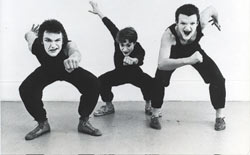 Thought it might be useful to look at some of the influences on our PUSH ME artists – to look at where their work sits and what it can be compared to. It’s always going to be a subjective take, as we all read different things into the work that we see, and gain impact from different elements.
Thought it might be useful to look at some of the influences on our PUSH ME artists – to look at where their work sits and what it can be compared to. It’s always going to be a subjective take, as we all read different things into the work that we see, and gain impact from different elements.
Starting with the work of Ramesh Meyyappan, it’s hard to describe his style of theatre accurately – it’s rooted in physicality, using gesture, mime, facial expression and elements of sign language, yet the catch all term ‘physical theatre’ seems too broad to do it justice.
Personally, I’ve been a fan of this type of physical theatre since attending the London International Mime Festival in 1979 and saw Moving Picture Mime Show’s The Seven Samurai and other stories. It was an epic tale told through moving hands, faces and bodies – hysterical and technical in equal measure, and easily accessible to all. Ramesh Meyyappan’s work is reminiscent of this form of embodiment – detailed, intricate and precise.
But what is physical theatre? Wikipedia defines it as follows:
Physical theatre is used to describe any mode of performance that pursues storytelling or drama through primarily physical and secondarily mental means. Several traditions of performance all describe themselves as “physical theatre”, which has led to considerable confusion as to how physical theatre should be defined. The means of expression seem to be primarily physical rather than textual, often augmented by musical elements. Many of these various Physical Theatre traditions share a collaborative devising approach to theatrical development and creation; various groups, such as DV8, Frantic Assembly, Forced Entertainment and the Double Edge Theatre all use differing but nonetheless devising-based processes.
Much of Ramesh’s work involves his hands – as a natural extension of sign language. In this way, he follows on from the work of Andrew Dawson, in particular his extraordinary Space Panorama (the best clips online are in a short film he made for The Wellcome Collection about The Articulated Hand). This piece really shows how dexterous and exact he managed to be.
Dawson went on to develop full sized theatre pieces such as Thunderbirds FAB with his company, Mime Theater Project. I remember seeing this with my son (now 15, then aged 5) and the whole family walking back to the car trying to ‘wobble’ like the portrayals of the Thunderbird characters we’d witnessed.
Ramesh’s work is seeped in a rich cultural history of sign language poetry, theatre and sign song, pushing this dexterity out beyond a niche deaf audience, fully into the mainstream. In some ways, he has the popular appeal of performers such as David Armand and his so called ‘interpretive dance’ – see his interpretations of:
- Human by The Killers
- Love Is All Around by Wet Wet Wet
- Don’t Stop Me Now by Queen
It’s not signed song but there is definitely a nod in that direction, and he has the speed and precision of Meyyappan but uses it for comedic effect.
Ramesh’s skill for me in Skewered Snails is that he takes these skills and points them in the opposite direction – its not simply played for laughs. The tale is dark and tragic, the tension heightened. Holding the audience in a place of suspense is masterful and I think Ramesh Meyyappan is up there as a master of this art.